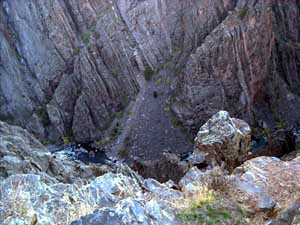|
|

The canyon and its
rims are home to a variety of wildlife, from the chipmunks and ground
squirrels to weasels, badgers, marmonts, and black bear. Infrequently bobcat
and cougers are sighted, and at night , coyotes may be heard. If you come
across trees that have been gnawed on, you will have found evidence that
porcupines are thereabouts, for the bark of pinyon pine is one of the
favorite foods of these nocturnal animals. The Gambel oak and serviceberry
that cover most of the Gunnison Uplift provide a good habitat for towees,
western tangers, pinion and scrub jays, and black-billed magpies. The cliffs
are home to white-throated swifts, violet-green swallows, golden eagles,
turkey vultures, and red-tailed hawks, who all take advantage of the
updrafts for soaring. The canyon is one of the last shelters in Colorado for
the endangered peregrine falcon. Through a home to wildlife, the canyon has
been . a mighty barrier to human beings. Archeological evidence indicates
that prehistoric man, and later the Utes, used only the canyon rims, never
living in the gorge. The first white men to see the great chasm actually
were members of the Hayden Expedition in 1873-74. It appears that the
Spaniards, including the famed Dominguez-Escalante Expedition in 1776, all
missed the canyon as they came over the Uncompahgre Plateau and into the
Uncompahgre Valley on various journey's of exploration. Even the group led
by Capt. John W. Gunnison, whose name has become permanently attached to the
river, bypassed the gorge itself in its search for a river crossing. The
Hayden Expedition and later surveying parties for the Denver & Rio
Grande Railroad all pronounced the Black Canyon "inaccessible".

|

